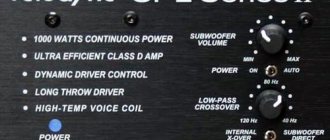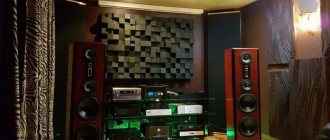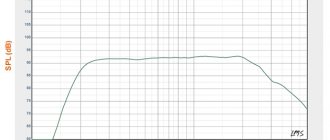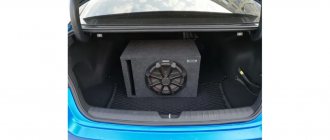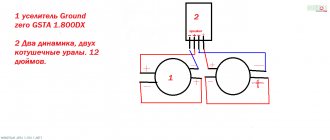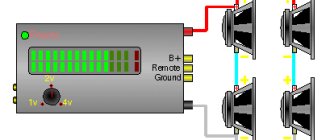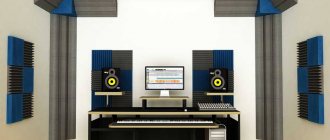Almost every car enthusiast has at least once wondered about installing a high-quality sound system in their car, allowing them to maximize the potential of a good radio. At the same time, most often, it was the selection of a subwoofer that turned out to be a rather labor-intensive task, in order to solve which it is necessary to delve into a considerable number of technical nuances. The situation is also complicated by the wide variety of models of modern acoustics presented on the audio market by various brands specializing in the relevant field.
Necessary clarifications
1. This should actually turn out (and it turned out!) to be a very good subwoofer . All my “doubts” and statements such as “this is not the best solution” should be understood as follows: “Any thing can always be improved at least a little. But the cost of this improvement will be enormous.” Or: “In principle, of course, we can do it a little better, but still there won’t be a noticeable difference.” It’s just that I (being a philosopher at heart) do not recognize absolutes. Someone else in my place would write “powerful hurricane sound, exciting quality, killer bass, shaking the floor and ceiling.” And in this case I say: “sounds really good.” So understand correctly. I am not an advertiser and am not prone to beautiful phrases, even to my detriment.
2. I make this sub exclusively for myself. This does not mean that it cannot or should not be repeated. This means that when choosing its optimal characteristics, I took into account something that is unique to me, but may not be relevant for others. Namely: I am very strictly limited in size - I have nowhere to put it. There is only one place in the entire house for a sub, and it has to fit there, period. According to the rules, dimensions are chosen based on the best sound, and now I have to do it in order to get the best sound in the given dimensions.
3. This is a rather long-term project. For several reasons. And the materials will be filled gradually. Moreover, I will not hide unsuccessful solutions, but will try to publish them (understand correctly, during the setup process dozens, if not hundreds of options arise and are discarded; I hope no one thinks that I will describe them all?), so that you get a description of the process ( God bless you!) and search for the optimum. I will also try to try and publish options that I either come up with myself or someone will tell me. So I am ready for criticism (constructive), and for accepting advice, and for experiments.
4. I am not a “victim of circumstances” in everything. Some things I think (at the moment) are the most correct. I will try to explain my point of view, but if something is unclear or (in your opinion) unsuccessful, ask, I am ready to both explain and argue. Look, some kind of truth will emerge from that dispute!
Initial data
You need to make the best sounding subwoofer :
Sound material: music (various, but not “punt-punt”, but “musical”) and cinema.
Dimensions LxWxH: 500 x 320 x 500 mm. And no more!
Frequency range (indoors): 18…100 Hz.
Power: enough for 20...40 m2.
Looking ahead, here is what happened (modified Sven-620), and what happened - without a grill:
| Was | It became |
Manufacturers and costs of subwoofers
The price for a more or less normal passive subwoofer of decent sound quality starts at $100, so you shouldn’t rely on cheap products from “no-name” manufacturers. At best, they will simply sound unsatisfactory. At worst, they will burn out from overload due to inflated power figures provided by unscrupulous sellers. Often the following brands sin in this way - Mystery, Supra and similar “general-profile manufacturers”.
Ideology
The sub in the system should be invisible! It shouldn’t make you shake, the walls shouldn’t shake (all this, of course, is in music). They shouldn't overpower the bass. It should sound like what the authors of the music sounded in the original. However, the original has frequencies of 25 Hz and lower. This means they need to be reproduced. And reproduce it with high quality. But in the movies, yes, you can shake the walls (but be careful so they don’t collapse!). And such high quality is not required. It turns out that in music, the volume is lower - the quality is higher. In the movies it's the other way around. This is a completely feasible situation. The main thing is that there is an appropriate frequency range and power reserve. Then, if everything is OK in music, then everything will be OK in cinema.
I basically make a passive sub! The amplifier will be separate. The benefits of such a solution are immeasurable:
- Precious storage space is not occupied by the amplifier.
- There are no problems with sealing and vibration isolation of the amplifier box.
- There are no problems with cooling the amplifier and with free space for it.
- You don't have to climb onto the back wall of the sub in order to turn the knobs. There will be no need to look for them by touch and turn them by touch (in my old Sven, I periodically forgot which of the knobs - the level or the filter - was on the right, and which one was on the left, and often turned the wrong one).
- The sub can be moved with her ass close to the wall.
- The amplifier can be made and remade as much as you like. Scheme, design, dimensions, parameters - change it at least 1000 times!
- Convenient to set up - no need to remove the sub every time to resolder one resistor.
Naturally, I will describe both the amplifier and the Linkwitz corrector.
Now on to the frequencies. I believe that the optimal section of a subwoofer-speaker system is approximately 80 Hz. It is difficult for speakers to reproduce lower frequencies (large floor standing speakers play well up to 60 Hz, but I have bookshelf speakers). It may be objected to me that the passport for the speakers says from 30 Hz. Yes, it will reproduce 30 Hz, but with what quality? Conventional speakers (even good ones) have enormous distortion at these frequencies. These 30...40 Hz are difficult for them. But the subwoofer (shown on page 3) reproduces these frequencies remarkably well. And virtually no distortion. Now why shouldn't the subwoofer play above 80 Hz? Sorry, it's still a subwoofer. Translated, it means “bark maker.” It reads, the main role is still behind the speakers. And normal speakers should reproduce 80 Hz normally. More precisely, if the speakers play from 40...60 Hz, then for them 80 Hz is light, and there is little distortion there. True, I have come across multimedia acoustics in which the subwoofer frequency band was 160...400 Hz. But that's not what we do, is it? It’s not for nothing that George Lucas chose exactly this crossover frequency in the THX standard! Therefore, I set the upper operating frequency of the subwoofer to 100…160 Hz. With reserve. And I carry out some measurements only up to 100 Hz - it won’t go higher.
Preliminary estimates
1. The larger the diameter of the diffuser and its linear stroke , the better the reproduction of low frequencies.
2. The the speaker , the better it works and sounds.
Therefore, I chose the Peerless 830500 (a significant role in its choice was played by the fact that I bought it on sale for half the price - its price is not small). Overall, this is an awesome speaker! It's been discontinued, but there are new speakers that are just as good.
3. Acoustic design of the bass reflex type (FI) allows you to get more bass than a closed box (ZY). I did not consider other designs, such as bandpass - they are very difficult to make “fast”, so it is very difficult to get a good sound in music from them.
4. On the other hand, FI is much more difficult to tune (especially at such low frequencies, where the room is very influential). And he doesn’t forgive mistakes - if you don’t adjust it enough, he will play poorly. In this regard, ZY is much simpler.
5. And the FI pipe can turn out to be so big that you can’t squeeze it into my small box! (The diameter of the FI is at least 1/5 of the diameter of the diffuser, and the length of the pipe is greater, the larger its diameter and the lower the frequency. Therefore, with a diameter of 12 inches and a frequency of 20 Hz, the length is about a meter!)
Therefore, I chose the “closed box” acoustic design (in fact, the type of design is selected simultaneously with the speaker). In my case, all the disadvantages of PL are easily overcome:
- The ZY has less bass response - I use a Linkwitz corrector to raise the bass.
- ZYa has more distortion at the lowest frequencies than FI - the speaker is good enough and the distortion will be small.
In addition, the advantages of ZY:
- The frequency response decreases less quickly at low frequencies. For example, if the lower frequency is 50 Hz, then at a frequency of 25 Hz the FI will sound 4 times quieter, and the ZY will sound only 2 times quieter.
- Faster bass. (In fact, in FI you can also get “fast bass”, but it’s more difficult: if in FI you need to try hard, then in ZY you need to try not to get such bass!)
But when registering a notice, even though it is the simplest, there are nuances. On the one hand, the larger the box, the greater the efficiency of the subwoofer (within reasonable limits), so by reducing the volume I will also reduce the volume. So 40...50 liters is not enough, but what can I do - the sizes are limited by my apartment. Therefore, I take a speaker of quite high power - I will supply more electrical energy to it, and I will get the desired volume. Those. due to the decrease in efficiency, instead of 20 W (as with conventional speakers), I will have to supply 60 W, or even more. My speaker is 200 W, so it will hold up. On the other hand, the larger the volume, the lower the quality factor of the subwoofer column, and the worse its frequency response at the lowest frequencies. To "raise the low end" I use an amplifier with an adjustable output impedance and a Linkwitz equalizer. Their combined use will give an excellent frequency response.
That’s why I describe everything in detail, because this design is easy to repeat. And she will play well at the same time!
The best passive subwoofers in a closed enclosure
A passive subwoofer requires an amplifier and precise calculation of all sound parameters in the overall circuit of car acoustics. But any deviation from the standard values in the system will lead to failure of the amplifier and speaker cables, as well as to disruption of the sound quality of all speakers in the chain.
JVC CS-BW120
5
★★★★★
editorial assessment
96%
buyers recommend this product
The CS-BW120 is part of the Bass Reflex Ported class of bass reflex subwoofers, delivering a peak power of 1300 W. Supplied in a closed housing with a diffuser size of 12 inches (30 cm) for installation in the trunk of a car with a small installation depth of 128 mm.
The housing is equipped with a damper suspension (foam rubber) and covered with acoustic fabric, which eliminates resonant interference at rated load. The frequency response range covers 37-2500 Hz, the sensitivity of the subwoofer is 87 dB.
The head material is a ferrite magnet, the output terminals are made of alloys using silver. As a result, the resistance in the circuit at permissible input power is only 4 ohms.
Pros:
- Balanced characteristics;
- Small installation depth (suitable for installation in cars with a small trunk);
- High-quality case materials;
- Built-in suspension;
- Reinforced diffuser;
- Bass reflex.
Minuses:
- Heavy weight (8.5 kg)
JVC CS-BW120 is designed for a complex speaker system using an additional amplifier and special speaker cables in a common circuit. Paired sets of such subwoofers successfully participate in car audio competitions.
JL Audio CP212-W0v3
4.8
★★★★★
editorial assessment
88%
buyers recommend this product
The design feature of this model from JL is two low-frequency speakers with a power of 600 W each, located frontally in the housing. This arrangement allows you to achieve ultra-low bass frequencies in the nominal operating mode.
An additional benefit will be load distribution. The impedance indicator in this case is divided multiple times and amounts to 2 Ohms, which makes it possible to install amplifiers in a common system of smaller capacity. The diffusers are protected by grills and recessed into the housing.
Pros:
- Relatively small dimensions (797x386x516 mm);
- Front placement of two speakers;
- Additional protection for diffusers;
- The presence of a damper gasket;
- Bass reflex type.
Minuses:
- Average power.
JL Audio is ideal for creating additional background ultra-low frequencies. The housing design occupies a small volume.
JBL Stage 1200B
4.7
★★★★★
editorial assessment
84%
buyers recommend this product
The successful model from JBL Harman offers 250 W of rated power from a 12-inch speaker in a classic MDF box covered with acoustic fabric.
The sub is in demand among lovers of high-quality audio systems without unnecessary frills. It is made according to a classical design in a body that follows the geometry of the luggage compartment of a car.
Pros:
- Classic layout;
- Bass reflex type;
- High quality material;
- Diffuser protective inserts;
- Low price.
Minuses:
- Lack of settings.
JBL Stage 1200B - good quality from the world leader, better known for its budget but good acoustics.
READ ALSO
6 best Pioneer car radios
Design
Making a subwoofer myself is almost impossible for me. So I ordered it online. There are real professionals working there - after carefully examining the building, I couldn’t find anything to complain about!
Here are the pictures.
| You need to get something like this. There are external dimensions, the wall thickness is at least 25 mm. The speaker is slightly off-center. This is not even so that there are fewer standing waves (at such frequencies the wavelength is much longer than the dimensions of the housing and it is unrealistic to get a “riser” with such dimensions of the housing), but for greater strength of the front wall. And for beauty. | |
| Front view. The diameter of the speaker is so large that the width of the case fits “to the limit.” If you insert it into the hole, the sides of the basket will rest against the walls from the inside! Therefore, the walls need to be milled a little. | |
| Side view. The spacers are visible. The hole for the terminals is covered with a lid (so that the terminals are not blown out by air pressure). | |
| Here he is, darling! They did well. The photo shows it poorly - they even coated the inside walls with glue so that air would not leak through the MDF (MDF is slightly permeable - there is such a drawback). The outside is finished with veneer. | |
| The spacer and round terminal cover are visible. And you can see the milled walls on the sides near the hole for the speaker. | |
| Another view of the struts. There is a hole in the round cover for the wire. Then it will need to be properly sealed. | |
| Even though I trust the manufacturers, I decided to seal the joints with sealant. I used Moment silicone sealant and covered the joints with window bead for strength. The fact is that the pressure inside the subwoofer is quite high, so reliability will not hurt. Yes, and you need to do something yourself! I didn't have enough white sealant, so I glued the vertical strip in the background with transparent sealant. The result is completely invisible glue - only the glazing bead is visible! | |
| The first layer of vibration absorber is STP material. It is rigid thanks to the corrugated aluminum. At low frequencies there is no alternative to it! I sealed everything except the terminal cover. | |
| The second layer is isolon (8 mm) on guerlain. Both vibration absorber and sound. True, at such low frequencies it is almost impossible to “absorb sound”! But still... In addition to working at subwoofer frequencies, it has one more important job: dampening the own resonances of the subwoofer walls. The next page shows how well he does this. You can read about vibration absorbers here: Something about vibration absorbers. I have already tested this solution (a multilayer “sandwich” made of MDF walls, guerlain, corrugated aluminum, again guerlain and isolon) and showed itself to be the best. There is practically no alternative to it! At low frequencies, most vibration absorbers do not work, but there is something to absorb there. | |
| The back part was filled with padding polyester. True, it’s not enough—100 grams, probably. A wide (but thin) sheet of padding polyester was inserted under the spacer so that it would act as a wall - it would hold the filler in the back of the case and not allow it to get into the speaker. The case should be filled by volume. The material that is near the walls (isolon) practically does not work to increase the effective volume - the frequency is too low. Volumetric filling is much more effective in this regard. | |
| Old and new. The new one will take the place of the tweaked Sven-620. |
Measurements
An interesting point - how much vibration absorber is needed ? There is an opinion that it is not needed at all, only spacers are needed. Indeed, if the sub is completely filled with spacers, then nothing else is needed. But still? Low-frequency vibrations (with frequencies of 10...60 Hz) can hardly be suppressed by a vibration absorber. Double walls, the space between which is filled with sand, help here (in addition to spacers). This doesn't suit me. But the walls can vibrate not only with the frequency emitted by the speaker. They also have their own resonance. Let's check: I tapped the wall with my finger and heard a rather noticeable sound: something like a ringing. I leaned the microphone against the wall, tapped with my finger - that’s right, the wall has its own vibrations with a frequency of about 1 kHz. Here are the original wall vibration spectra, and with a double (STP + gerlen-isolon) vibration absorber. The result is obvious.
Side wall :
Top wall:
It is clearly visible that in addition to mid-frequency overtones (in the region of 500...700 Hz), overtones in the subwoofer range have noticeably decreased - below 100...200 Hz, and this will have a good effect on the sound. This is mainly due to the STP material.
And in the end, what happened? Here is the frequency response of my subwoofer in the near field (with an amplifier output impedance of 3 ohms):
It turned out awesome! I deliberately took a linear scale along the frequency axis to make it clearer. A rollover at 20 Hz equal to 15 dB is very little, but if you correct it with a Linkwitz corrector, it will be wow!
This is a near-field measurement (i.e. without room influence). And the room raises the lowest frequencies, so even without a corrector, the room will actually sound better - more bassy.
Even in this form, the subwoofer sounds very decent. The old sub was generally silent below 30 Hz, but it turns out there is life below 30 Hz! Not on all music, but there is some. And the sound becomes more fundamental. And, oddly enough, more transparent! I never would have thought that bass could be transparent! The sound is just completely different, the bass envelops you, you just bathe in it! I’ll be honest - a significant part of the emotions relates to the corrected subwoofer - it sounds better with the corrector. But more on that later.
For comparison, I will give the frequency response of a subwoofer from a rather expensive multimedia kit. Look carefully: it mumbles at one frequency of 80...110 Hz, and above and, most importantly, below there are continuous rubble. 50 Hz is reduced by 12 dB, and 30 Hz by as much as 24 dB! You can't really hear the lows in it at all!!!
The frequency response of many car subs is similar - listen in passing cars - the subs also drone on the same note. By the way, the “manufacturers” of modern DJ (club) music know this and specifically make the bass on one note at a frequency of about 80 Hz - so that it “beats” well and loudly in such subs.
And now I’ll try to answer the question - why the bass is so transparent. Here is the non-linear distortion of the subwoofer (distance to the microphone is 5 cm, the voltage on the speaker is 3 V (amp), while its volume corresponds to listening to music "normally, not very loud", with a level of about 75 dB - this is a comfortable listening level for most people) :
Rating: “Excellent” - in most of the spectrum, harmonics are noticeably less than 1%! Higher harmonics are practically absent (the THD graph practically coincides with the 2nd harmonic graph). Almost only the 2nd and 3rd harmonics are present, with the third harmonic being quite negligible!
The significant (relatively) second harmonic, in my opinion, is caused not so much by the properties of the speaker, but by the small volume of the box. As the diffuser moves inward, the air in the box is compressed and the pressure increases. When moving outward, the pressure in the box drops and a vacuum occurs. But this happens in different quantities: the increase in pressure is stronger than the vacuum (the smaller the box, the greater the difference). This is the asymmetry, hence the second harmonic. At frequencies above 40 Hz Kg does not exceed 1%. This is just great, because almost all the sound is here! For comparison, ordinary speakers (expensive and good) have many times more kilograms at frequencies of about 40 Hz! Here, for example, is the distortion of the Dali IKON 7 speaker for $1500 (information taken from here: https://www.stereo.ru/test.php?article_id=156&page=2&tree_id_1=59):
Below 40...60 Hz, distortion increases sharply and reaches many percent, while in the subwoofer the distortion in the worst case barely exceeds one percent. By the way, this is one of the big advantages of having a subwoofer in the system: even the best speakers have enormous distortion at low frequencies, while a good subwoofer has little.
It is interesting that in comparison with the second harmonic, the third harmonic is much (almost 10 times) lower (and even higher harmonics are 10 times lower) - by ear the second harmonic is practically not perceived as “bad-sounding” (but the third and especially even higher ones are perceived). Some even consider the second harmonic to be “good-sounding” and introduce it into the equipment using all sorts of “improvers” (for example, this is how “tube” sound is simulated). So what did we get? A small and “good-sounding” 2nd harmonic and a meager 3rd. This is where the purity and transparency of the sound come from.
Assessment of subwoofer dynamics. Transient process - reaction to a package of five periods of a sinusoid:
The pink graph is what came from the amplifier, the black graph is the signal from the microphone (near field, 2 cm). Amplifier with linear frequency response except for the input capacitor (cutoff frequency 12 Hz). Conclusion - the sub is quite fast. It should give a clear, fast and clean bass (and it does! It doesn’t “buzz” or “fart” at all, like Sven did!). The long tail in the bottom graph is the 50 Hz background in the amplifier. For now, the amplifier is temporary and not of very high quality. Yes, there is a slight time delay - at 25 hertz the phase is inverted, but this is not noticeable by ear. In addition, pay attention to the absence of any unnecessary overtones - the sound signal practically repeats the electrical signal - the package of sound sinuses begins and ends simultaneously with the voltage.
For comparison, I’ll give a graph of the transient process of the Sven-620 subwoofer, which I changed quite a lot, after which it began to sound noticeably better. At a frequency of 25 Hz, the microphone is in front of the diffuser and at the bass reflex. It can be seen that the sound (black line) makes a lot of “unnecessary movements” and is highly distorted.
And at a frequency of 60 Hz: long “swing” and long “tails” of decay.
So, in terms of “bass speed”, my new sub beat Sven in all respects. At the same time, its sound is “deeper” and “fuller” and much cleaner. But Sven is a “pretty good sounding” sub, just my new one – a great sounding sub!
True, there is also a fly in the ointment in this barrel of honey: when the sub plays loudly, everything in the house begins to rattle. And when it is very loud (and with a large rise at frequencies of about 20 Hz), it seems that even the ceilings are rattling!
The best active subwoofers
The active sub is equipped with an amplifier, which is included in the kit - all sound parameters in it are calculated for ideal balance in any audio system.
Audision APBX 10AS
4.9
★★★★★
editorial assessment
96%
buyers recommend this product
The design of this subwoofer is compact and suitable for installation in any standard speaker system. New HE-LI (High Efficiency - Low Impedance) technology in flexible digital equalizer settings allows you to produce excellent bass dynamics in high sound quality.
The maximum power of the subwoofer is 800 W, the built-in frequency filter with a range of 20-200 Hz can work equally well in two modes: Lo-Pass / By Pass.
Pros:
- Digital filter “Subsonic”;
- Small dimensions (460x158x338 mm);
- Availability of two operating modes;
- Remote control;
- Built-in overload and short circuit protection.
Minuses:
- High resistance in the circuit - the fuse is 30A.
Audision APBX 10AS belongs to a new generation of speaker systems with an individual character of bass delivery.
Pioneer TS-WX300A
4.8
★★★★★
editorial assessment
91%
buyers recommend this product
From Pioneer's line of active subwoofers, the TS-WX300A model stands out with its peak power of 1300 W. The classic design with a 30-liter trapezoid body and a 12-inch speaker gives a powerful bass reflex resonance of 80 Hz.
The diffuser is covered with an original designer grill, emphasizing the individuality of the subwoofer. The device fits perfectly into the luggage compartment of the smallest volume, having dimensions of only 505x380x175 mm. Clear bass sound without distortion is guaranteed even at maximum power.
Pros:
- Increased power;
- Original design;
- Thoughtful type of case;
- Diffuser protection;
- Balanced sound pressure range 93-95 dB.
Minuses:
- Lack of Subsonic filter.
Model TS-WX300A is a prepared bass for a powerful speaker system with the ability to install eight or more midrange speakers.
Kicx EX12 BA90
4.8
★★★★★
editorial assessment
90%
buyers recommend this product
The EX12BA90 active subwoofer model differs from previous models in the series by having protection against overheating, overloads and short circuits. The built-in amplifier has two line inputs - separately for low and high frequencies.
High-quality suspension material made of natural butyl rubber allows you to operate without problems in the frequency range of 40-2500 Hz, delivering a maximum power of 600 W.
Pros:
- High-quality case materials;
- Set of speaker wires included;
- Balanced power;
- Possibility of frequency settings;
- Built-in protection.
Minuses:
- Heavy weight (13.5 kg) and case dimensions 570x430x395 mm.
Kicx EX12BA90 is a full-fledged bass for installation in the trunk of a car and connection to a standard audio system without additional devices.
Correction
I recently threw away a stack of about 60 sheets of paper. These were drafts and different versions of the Linkwitz proofreader for my sub. I tried a lot of options before I came to this result.
The very first version of the corrector was designed to obtain a -3 dB rolloff at a frequency of 20 Hz (see “Professional calculation of the Linkwitz corrector“). Turned it on and drowned in the bass! The bass played with such terrible force that the rest of the music behind them could not be heard. What's the matter? The thing is, I forgot about the influence of the room. The room, being “also a housing installed on the other side of the diffuser,” raises the lowest frequencies. How much and which ones depends on the shape and size of the room. In my 16 m2 the rise was simply colossal!
What to do? I need to set up the corrector so that the sub itself, the corrector and the room all together give the frequency response I need. First, I used an amplifier with a higher output impedance. This is what the calculated frequency response of my sub looks like at zero output impedance and an output impedance of 3 Ohms:
It is clear that with zero resistance this is not a subwoofer at all - the lows are overwhelmed with terrible force. Increasing the output impedance is very useful - the speaker moves more freely at low frequencies (because it is less damped), but on the other hand, it is more clearly controlled, because more controlled by current. A resistance of 3 Ohms is the optimal resistance (if you used ITUN, you would have a huge hump at a frequency of 35 Hz and nothing more). You can read about the increased output impedance of the amplifier and its benefits, as well as how it’s all very easy to do here: Regulation of the output impedance of the UMZCH using a combined OOS.
If I had used a zero output impedance of the amplifier, then I would have had to adjust the frequency response much more strongly with a Linkwitz corrector, and the overload of both the dynamics and the amplifier would have been stronger. And so - it’s almost good without a proofreader, all that remains is to correct it a little.
So, here is the frequency response of the subwoofer in the near field (i.e. in free space):
And here is the frequency response after correction:
What changed? Firstly, the linear section extended to 40 Hz. Secondly, the rolloff has also decreased at lower frequencies: at a frequency of 20 Hz it was -15 dB, and became -8. Here are the same curves (measured under slightly different conditions and shown on a more familiar logarithmic scale - don’t the top graphs look more impressive?):
As it turned out, this is quite enough, the room does the rest - it raises the low ones to the desired level. Therefore, the frequency response of the corrector turned out like this:
It was very difficult to obtain such a weak correction in the Linkwitz corrector. However, I didn't want to give it up because... In addition to correcting the frequency response, it also corrects the phase response and improves the group delay time of the signal. This is the diagram I came up with:
This corrector is part of the preamplifier, the remaining parameters of which are known. Through this preamplifier, the signal is supplied from the receiver to the power amplifier, which powers the subwoofer. The preamplifier (by the way, the circuit turned out great!) includes many useful blocks, including a subsonic filter, a level control, a phase switch, an adjustable low-pass filter... So the preamplifier itself is suitable (and will be very useful!) for everyone, but This is exactly the corrector circuit - only for those who have the same subwoofer and the same room! If everything is different for you, just calculate your corrector yourself! But do not forget that the room raises the bass, so there is no need to chase a strong increase in frequency response below 30 Hz. This is what I got when installing the microphone at the listening point, i.e. taking into account the influence of the room:
As you can see, 20 Hz is not overwhelmed at all, but on the contrary, it is raised! But a dip in the region of 50 Hz is already irreparable (only by changing the room!), This is the influence of resonances, reflections, interference of my listening room. This blockage is not present in other parts of the room. But in the place where I sit, listening to music, it is there and I have to endure it. In general, it is possible to obtain a smooth sound frequency response at low frequencies only if you build a special house (such as a theater) and properly muffle it. But this is beyond my power.
If you “re-enchant” the correction and greatly increase the frequencies of 20...35 Hz, then it will be bad. The fact is that at these frequencies there is very little music itself, mainly all sorts of after-sounds, “tails”, overtones, echoes... Without them (if the low ones are not reproduced at all) the music becomes more “dead”, but if you turn them up, it turns out very unnatural. It begins to put pressure on the ears, the sound becomes “heavy”, the bass drum seems to be stuffed with cotton (the overtones of the bass drum fall very well into this range)... Therefore, be prepared for the fact that the Linkwitz corrector will have to be recalculated and resoldered several times. And listen carefully to the sound of the subwoofer. It shouldn't sound. It should not be visible in the system. It's just that when music plays, all the bass is in its place. Whether the sub is playing or is silent can only be determined by raising your ear to it. This means that the sub is configured correctly.
You can remove the full frequency response of the entire sound system:
All these waves in the characterization are caused by the fact that it was filmed not in a special anechoic camera, but in my home. The connection of the subwoofer is clearly visible - the low ones are not blocked and do not stick out. And I have audio from 20 Hz to 20 kHz with quite a bit of unevenness. Those. Not only the Hi-Fi standard is maintained, but we can also talk about Hi-End. Expensive systems costing many thousands of dollars are not ashamed to have such a characteristic. (By the way, you can’t buy a sub of this quality for less than one or two thousand dollars!!!)
The best compact active under-seat subwoofers
An active subwoofer is a ready-made source of low frequencies with its own amplifier. The latest models of this type, as a rule, have electronic control with a processor that allows you to adjust low-frequency sound parameters.
It’s easy to connect such a device to a general audio system - a standard power supply and an audio output signal are enough for it.
Special compact low-frequency devices are installed under the seat due to their small dimensions. At the same time, the power and quality of resonance are not inferior to full-fledged subwoofers with a large diffuser stroke.
Alpine PWD-X5
4.9
★★★★★
editorial assessment
95%
buyers recommend this product
An innovative model of an active subwoofer from the global manufacturer Alpine in 2022 received international recognition at the car audio exhibition in Las Vegas CES (Consumer Electronics Show).
The compact device runs on Android software with an eight-band equalizer, and each channel can be adjusted separately. The digital processor is compatible with a computer or smartphone - all settings can be easily controlled from the application.
Line-in connection to the overall audio system provides two pairs of outputs, USB ports and connector blocks for activating high-output switches. The control is equipped with an additional remote control with a separate channel via Bluetooth technology.
All output channels show a sensitivity of 82 dB with a power of 25 W each. The maximum power of the subwoofer reaches 240 W at peak values. The main achievement with such parameters is the range of frequencies that provide powerful sound without distortion within the range of 28-404 Hz.
Pros:
- Small dimensions (350x245x80 mm);
- 8-band equalizer;
- Android software;
- Compatible with standard acoustics;
- Classic sound configuration (front-rear-subwoofer);
- Excellent frequency range.
Minuses:
- Low power reserve;
- High price (from 40,000 rubles)
Alpine PWD-X5 is an excellent option for a car of any class. Sound quality plus digital support makes this device versatile.
JVC CW-DRA8
4.9
★★★★★
editorial assessment
93%
buyers recommend this product
An active subwoofer from the Japanese company JVC is a direct competitor to the Alpine PWD-X5 this year. It is even smaller in size (350x240x70 mm), but its maximum power is slightly higher - 250 W. Such a device can easily be installed under a seat, in the trunk or on the rear parcel shelf of a car without additional mounting elements.
The lack of digital adjustment of operating modes does not affect the sensitivity of the diffuser. Stable 95 dB are kept within nominal parameters without extraneous noise. The kit also includes a remote control.
Pros:
- Super compact;
- Clear bass at 108 dB peak;
- Full set (acoustic cables, fasteners, remote device);
- Low power consumption rating (10 A fuse);
- Price from 14,000 rubles.
Minuses:
- Lack of digital equalizer.
JVC CW-DRA8 – simplicity and quality without frills. Ideal for upgrading standard audio systems of budget cars.
